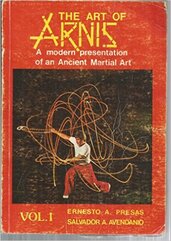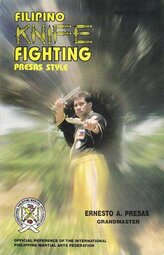GGM ERNESTO A. PRESAS BOOKS

The Art of Arnis
(with Salvador Avendanio credited as co-author), 1981.
Published by Ernesto A. Presas & Associates and the Arjuken Karate Association
This rare book features a unique glimpse into GGM’s art as it was taught in the 1970s and ‘80s. It includes photographs of a younger GGM with some of the earliest Arjuken pioneers: Roberto Presas, Pepe Yap, Willie Madla, Pepito Robas, Cristino Vasquez, Rey Yatsu, Rene Tongson, Jose G. Paman and Jackson Cui Brocka.
(with Salvador Avendanio credited as co-author), 1981.
Published by Ernesto A. Presas & Associates and the Arjuken Karate Association
This rare book features a unique glimpse into GGM’s art as it was taught in the 1970s and ‘80s. It includes photographs of a younger GGM with some of the earliest Arjuken pioneers: Roberto Presas, Pepe Yap, Willie Madla, Pepito Robas, Cristino Vasquez, Rey Yatsu, Rene Tongson, Jose G. Paman and Jackson Cui Brocka.

Arnis Presas Style and Balisong
Manila, 1988.
An elaboration of the prior book, this volume illustrates many techniques from the three main categories of stickfighting, solo baston, doble baston and espada y daga. The anyo, forms, of Kombatan are described in great detail, as are numerous fighting applications of the techniques. Empty-hand defenses against weapons are presented at length. A section on the balisong, the fan knife, explains methods of opening, closing and manipulating the native Filipino knife.
Manila, 1988.
An elaboration of the prior book, this volume illustrates many techniques from the three main categories of stickfighting, solo baston, doble baston and espada y daga. The anyo, forms, of Kombatan are described in great detail, as are numerous fighting applications of the techniques. Empty-hand defenses against weapons are presented at length. A section on the balisong, the fan knife, explains methods of opening, closing and manipulating the native Filipino knife.

Filipino Modern Mano-Mano
Manila: Ernesto A. Presas, 1996.
This manual reveals in detail the art’s empty-hand strikes and kicks. Of equal importance to Kombatan’s armed techniques, mano mano techniques provide the self-protection skills in the event that the practitioner is forced to engage in combat without his stick or blade.
Manila: Ernesto A. Presas, 1996.
This manual reveals in detail the art’s empty-hand strikes and kicks. Of equal importance to Kombatan’s armed techniques, mano mano techniques provide the self-protection skills in the event that the practitioner is forced to engage in combat without his stick or blade.

Filipino Knife Fighting Presas Style
Manila: Ernesto A. Presas, 1998.
The essence of knife fighting is taught in this manual.
Grips, blocks, cuts, thrusts and combinations are fully described, as are many practical applications
Manila: Ernesto A. Presas, 1998.
The essence of knife fighting is taught in this manual.
Grips, blocks, cuts, thrusts and combinations are fully described, as are many practical applications

Filipino Armas de Mano Presas Style
Manila: Ernesto A. Presas, 1996.
This book presents information on the lesser-known technical categories of GGM Presas’ art such as the dulo dulo, bangkaw and kris. A valuable text rounding out the Kombatan’s student’s education.
Manila: Ernesto A. Presas, 1996.
This book presents information on the lesser-known technical categories of GGM Presas’ art such as the dulo dulo, bangkaw and kris. A valuable text rounding out the Kombatan’s student’s education.

Filipino Police Combative Technique
Manila: Ernesto A. Presas, 1996.
Arnis techniques remain strong in the combative curriculum of police and military units in the Philippines. This book presents restraining and releasing methods, as well as the more serious and deadly aspects of armed conflict.
Manila: Ernesto A. Presas, 1996.
Arnis techniques remain strong in the combative curriculum of police and military units in the Philippines. This book presents restraining and releasing methods, as well as the more serious and deadly aspects of armed conflict.

Dumog Presas Style
Manila: Ernesto A. Presas, 2002.
Dumog (alternately called buno) is the grappling component of Kombatan allowing one to effectively deal with an attacker at extremely close quarters. Throws, takedowns, locks and groundfighting techniques are presented at length.
Manila: Ernesto A. Presas, 2002.
Dumog (alternately called buno) is the grappling component of Kombatan allowing one to effectively deal with an attacker at extremely close quarters. Throws, takedowns, locks and groundfighting techniques are presented at length.
